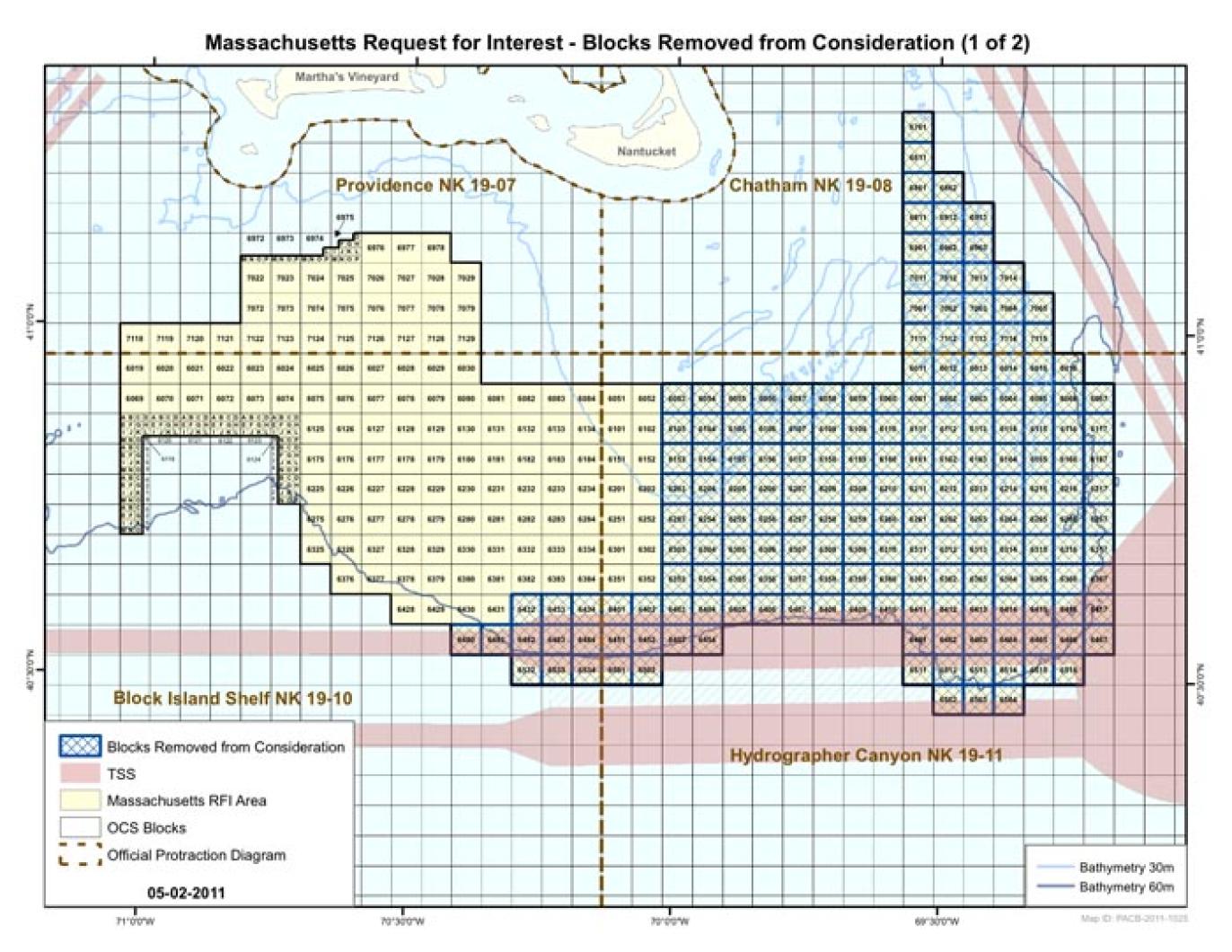Just two weeks after it finished accepting proposals from wind power developments in waters south of the Vineyard, the federal government has more than halved the area in which it will allow wind farms.
Citing concerns from fishermen, the state and others about potential adverse impacts, particularly on fishing and migrating marine mammals, the U.S. Bureau of Ocean Energy Management, Regulation and Enforcement has reduced the size of the prospective area from 3,000 square miles to 1,300.
As originally laid out, the Massachusetts Requests for Interest area encompassed a broad arc of ocean beginning at the Rhode Island border southwest of the Vineyard and extending 90 nautical miles eastward, then north around Nantucket, and as close as 14 miles to the Vineyard.
The changes take out all of the eastern half of the RFI area, as well as a narrow strip on its southern edge.
The changes will affect several of the 10 companies which were looking to lease blocks which have been removed. Most of the prospective interest, however, was within the area which still remains open.
Vineyard Power is unaffected. The local cooperative is jointly bidding for some 200 square miles of ocean — an area more than twice the size of the Vineyard itself — with its much larger partner, Offshore MW LLC.
The cooperative has plans to install in stages, up to 100 turbines, enough to generate 1,000 megawatts of electricity. Several other potential developers, including Cape Wind, have bid for overlapping areas, and also will be unaffected by the changes.
In announcing the reduction of the RFI area, the director of the bureau, Michael Bromwich, said they had acted on “significant concerns from the people of Massachusetts.”
The bureau received nearly 250 comments on the proposed area, among them submissions from the state congressional district, the Massachusetts governor’s office and commercial fishermen. All argued for the reduction of the area.
The changes reflect almost exactly what the state requested. It argued the smaller area still would produce enough power to meet the goal of generating 4,000 megawatts of wind energy, while still protecting the fishing industry which relies heavily on the area.
The state Secretary of Energy and Environmental Affairs, Richard Sullivan Jr., welcomed the changes.
“I am pleased the bureau . . . has agreed with our proposal to amend the potential offshore wind energy development areas, based on the best available science and feedback from industry stakeholders,” he said in a statement.
The federal bureau’s actions also highlight criticism of the federal “smart from the start” process, made by the Martha’s Vineyard Commission.
The commission expressed concern that BOEMRE was taking expressions of interest from those seeking to lease blocks for development even as it sought comments on the plan. Engaging developers before there had been more comprehensive study of the area and more comment from other parties, the commission termed “worrisome.”
“Our concern is that, once developers have selected certain blocks for development as required by the RFI, it will be difficult to relocate projects, especially after the developers have invested considerable time and money in studies of their original blocks . . .” the commission said.
Chilmark selectman and active advocate for the fishermen Warren Doty said the local industry had yet to analyze the changes to determine if they were satisfactory.
The fishermen have, however, called for changes to another proposed lease area, the so-called Area of Mutual Interest (AMI) southwest of the Vineyard in Massachusetts and Rhode Island waters.
“The fishing community has made a suggestion that they eliminate six blocks, each one of nine square miles that we think are important fishing areas,” Mr. Doty said. “We would suggest adding some other blocks, not in the area.”
If accepted, the fishermen’s proposal would leave the AMI a different shape, but the same in area, he said.
Interested parties have until May 11 to make submissions to the joint local state and federal task force reviewing the AMI proposal. Chilmark plans to make a submission.
At this week’s meeting of the Chilmark selectmen, Mr. Doty and selectman Jonathan Mayhew, who has a long background in fishing, spoke about the threat posed by the AMI as currently configured.
Parts of the area are heavily used by Vineyard draggers as well as lobstermen. Among the species affected were cod, yellowtail flounder, fluke and scallops.
Mr. Doty also expressed concern that the process should not simply award leases to the highest bidder, but should favor projects with greater benefit to the local community.
Gazette reporter Remy Tumin contributed to this story.






Comments
Comment policy »